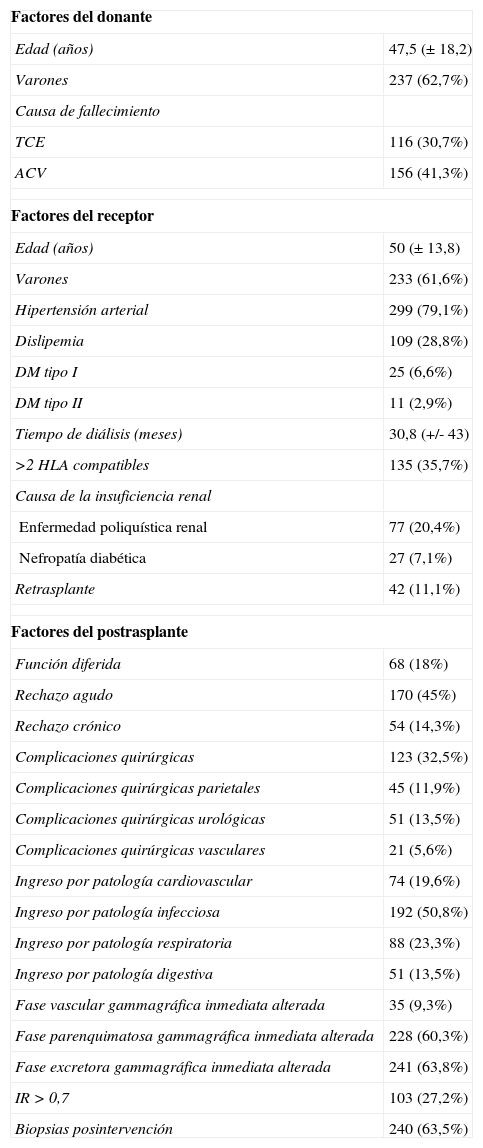Se pretende caracterizar la verdadera relación del tiempo de isquemia fría (TIF) con la supervivencia del injerto, así como con los principales eventos del postrasplante.
Material y métodosAnalizamos 378 trasplantes renales, estudiando la relación del TIF con la supervivencia del injerto mediante un análisis univariado según el modelo de COX, y buscando el mejor punto de corte mediante el método de Kaplan-Meier y test de log-rank. La relación entre TIF y los principales eventos del postrasplante fue estudiada con la regresión logística binaria.
ResultadosLa media de seguimiento de todo el grupo fue de 77,8 meses (± 51 DE) y el TIF medio de 14,8 horas (± 5,1 DE). El análisis univariado revela que el TIF no se relaciona con la supervivencia del injerto como variable continua (OR=1,04; IC 95% 0,9-1,08; p>0,05). Al establecer el punto de corte en las 18 horas encontramos diferencias en la supervivencia actuarial. La supervivencia a los 5 años es del 91% con TIF < 18h frente a 84% con TIF > 18h. Cada hora de isquemia fría incrementó un 10% el riesgo de retraso en la función del injerto (OR=1,1; IC 95%:1,05-1,15; p<0,001) y también condicionó mayor incidencia de rechazo agudo (41,5% vs. 55,3%; p=0,02) y menor tiempo hasta el primer episodio de rechazo (72,6 días±137 vs. 272,2 días±614,8; p=0,023) a partir de las 18 horas. Con el resto de eventos del postrasplante, tales como complicaciones quirúrgicas o ingresos hospitalarios, el TIF no pareció estar relacionado (p>0,05).
ConclusionesEn nuestra experiencia una isquemia fría menor de 18 horas no parece afectar negativamente la supervivencia del injerto.
It is aimed to characterize the true relationship of the cold ischemia time (CIT) with graft survival and with the principal post-transplantation events.
Material and methodsWe analyzed 378 kidney transplants, studying the relationship of the CIT with graft survival using a univariate analysis according to the COX model and seeking the optimum cutoff according to the Kaplan-Meier method and log-rank test. The relationship between CIT and the principal events of the post-transplant was studied using the binary logistic regression.
ResultsThe mean follow-up of all the group was 77.8 months (± 51 SD) and the mean CIT was 14.8hours (± 5.1 SD). The univariate analysis revealed that the CIT was not related with the graft survival as a continuous variable (OR=1.04; 95% CI: 0.9-1.08; p>0.05). On establishing the cutoff at 18hours, we found differences in the actuarial survival. Survival at 5 years was 91% with CIT < 18h versus 84% with CIT >18h. Each hour of cold ischemia increased risk of delay in the graft function by 10% (OR=1.1; 95% CI: 1.05-1.15; p<0.001) and also conditioned a greater incidence of acute rejection (41.5% vs. 55.3%; p=0.02) and less time to the first rejection episode (72.6 days±137 vs. 272.2 days±614.8; p=0.023) after 18hours. The CIT did not seem to be related (p<0.05) with the rest of the post-transplantation events, such as surgical complications or hospital admissions.
ConclusionsIn our experience, cold ischemia under 18hours does not seem to negatively affect graft survival.
Artículo
Comprando el artículo el PDF del mismo podrá ser descargado
Precio 19,34 €
Comprar ahora











